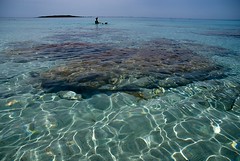
The islands of the Aegean are peaks of underwater mountains that extend out from the mainland. Crete is the last of this range and boasts a diverse beauty from its high mountains of Psiloritis, Lefka Ori, Dikti, to its ocean caressed pink sand beaches.
Much of the island of Crete is Miocene and filled with fossil mollusks, bivalves, gastropods who lived 5 to 23 million years ago in warm, tropical seas. They are easily collected from their pink limestone matrix and are often eroded out, mixing with their modern relatives.
Aside from the marine deposits, the island boasts some of the best vertebrate finds, including the remains of Deinotherium giganteum, a massive 8 million-year-old mammal and primative relative of the elephants roaming the Earth today.
With an enormous large nasal opening at the centre of his skull, presumably to house a rather largish trunk, Deinotherium may be the inspiration behind the myth of the Cyclops, the one-eyed giant from Homer's famous Odyssey.
Aside from the plentiful fossils, the beach is home to sun bathing locals and rare extant marine species. Pinniped seals and Loggerhead sea turtles call this part of the world home. The local fields hold lush, red cretan poppies and the mountains house rare orchids and the last of remaining lynx, Roe deer, Wild goat and brown bear.




Comments